When you’re diagnosed with multiple sclerosis, you’re told that the cause of MS is unknown, there is no cure and you will likely be disabled in time. The best medicine can offer is expensive immune-suppressing drugs that don’t stop progression.
But what if I told you that researchers have found parasitic worms in the spinal fluid of 100% of MS patients studied? Not 50%. Not 75%. Every single one.
And what if I told you that veterinarians have known for over a century that when these same worms infect the central nervous system of animals like horses, cattle, and sheep, they cause symptoms identical to MS— weakness, spasticity, paralysis, loss of myelin, and blindness?
You’d probably ask: “Why didn’t my doctor look for parasites?”
The answer is as frustrating as it is shocking.
The Declaration That Changed Everything
In the world of MS diagnosis and treatment, international expert panels made a declaration that has shaped medical practice for decades: examining spinal fluid under a microscope in MS patients “is always without any value.”
Read that again. “Always without any value.”
Because of this declaration, no pathologist in any hospital or medical school anywhere in the world routinely examines MS spinal fluid for parasites. They look at brain tissue. They do MRIs. They run antibody tests. But they don’t look at the spinal fluid under a microscope.
Not because it wouldn’t reveal anything. But because they declared—without actually looking—that it had no value.
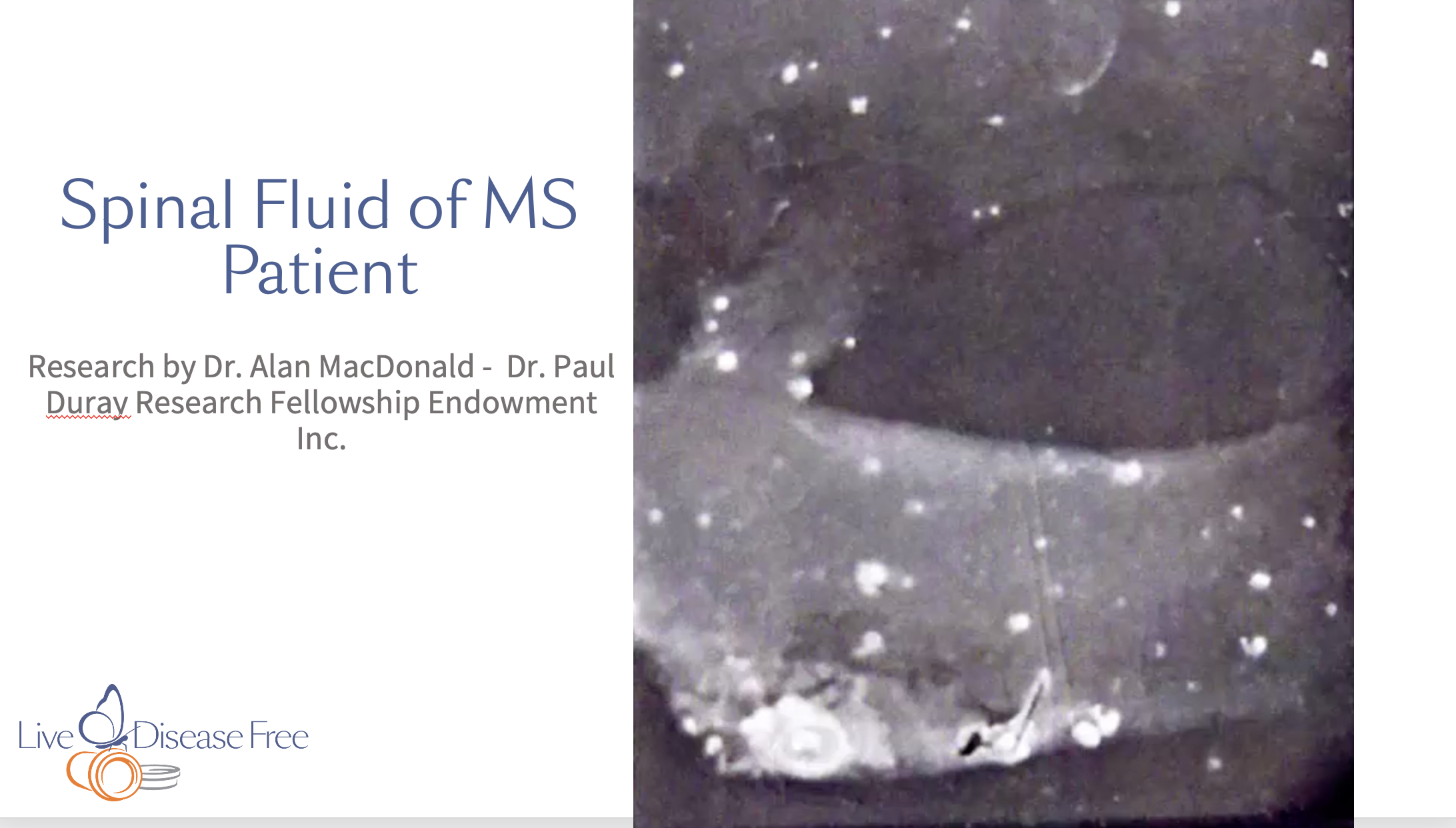
What Happens When Someone Actually Looks
In 2016, pathologist Dr. Alan McDonald did something revolutionary: he looked.
Dr. McDonald obtained spinal fluid samples from 10 MS patients from the Rocky Mountain MS Brain Bank. These were confirmed MS cases—patients who had died from the disease and donated their bodies to science. Their spinal fluid had been frozen since autopsy, some samples dating back to 1984.
For over 30 years, these samples sat untouched. Because looking at them had “no value.”
When Dr. McDonald thawed these samples and examined them under a microscope, here’s what he found:
10 out of 10 patients—100%—had parasitic worms in their spinal fluid.
He found:
- Adult filarial worms (small roundworms)
- Larval forms (baby worms developing)
- Fertilized eggs showing embryo development
- Mating pairs of worms—male and female reproducing
- Massive amounts of worm debris and waste.
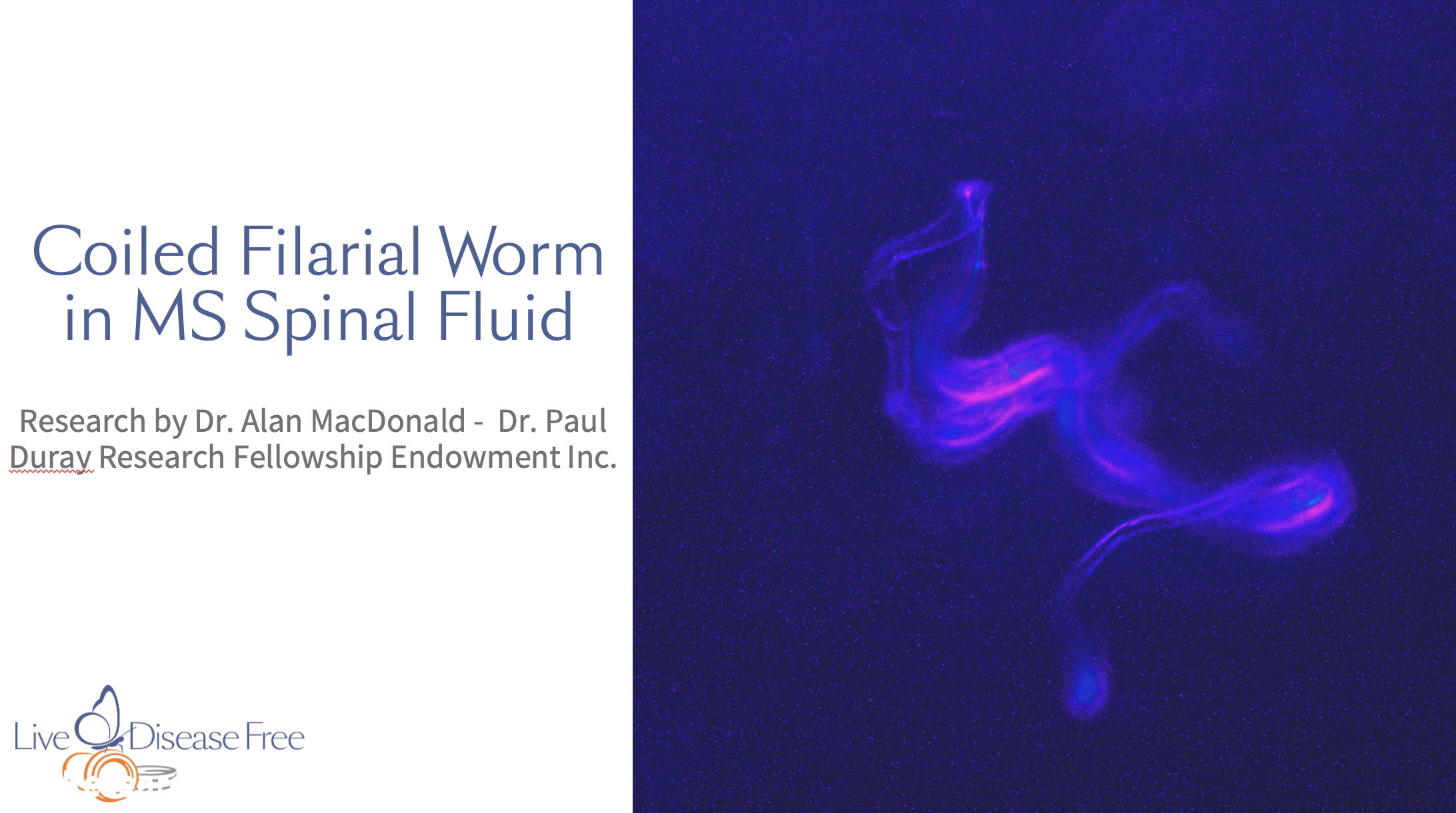
And here’s what made this discovery even more significant: these worms weren’t alone. When Dr. McDonald used special DNA testing, he discovered that these worms carry Borrelia bacteria—the microbe that causes Lyme disease—inside the worms.
The worms act like a Trojan horse. They move through the brain causing direct damage to myelin and nerves. Then when the worm dies, it releases all the Borrelia bacteria it’s been carrying, causing even more inflammation and tissue damage.
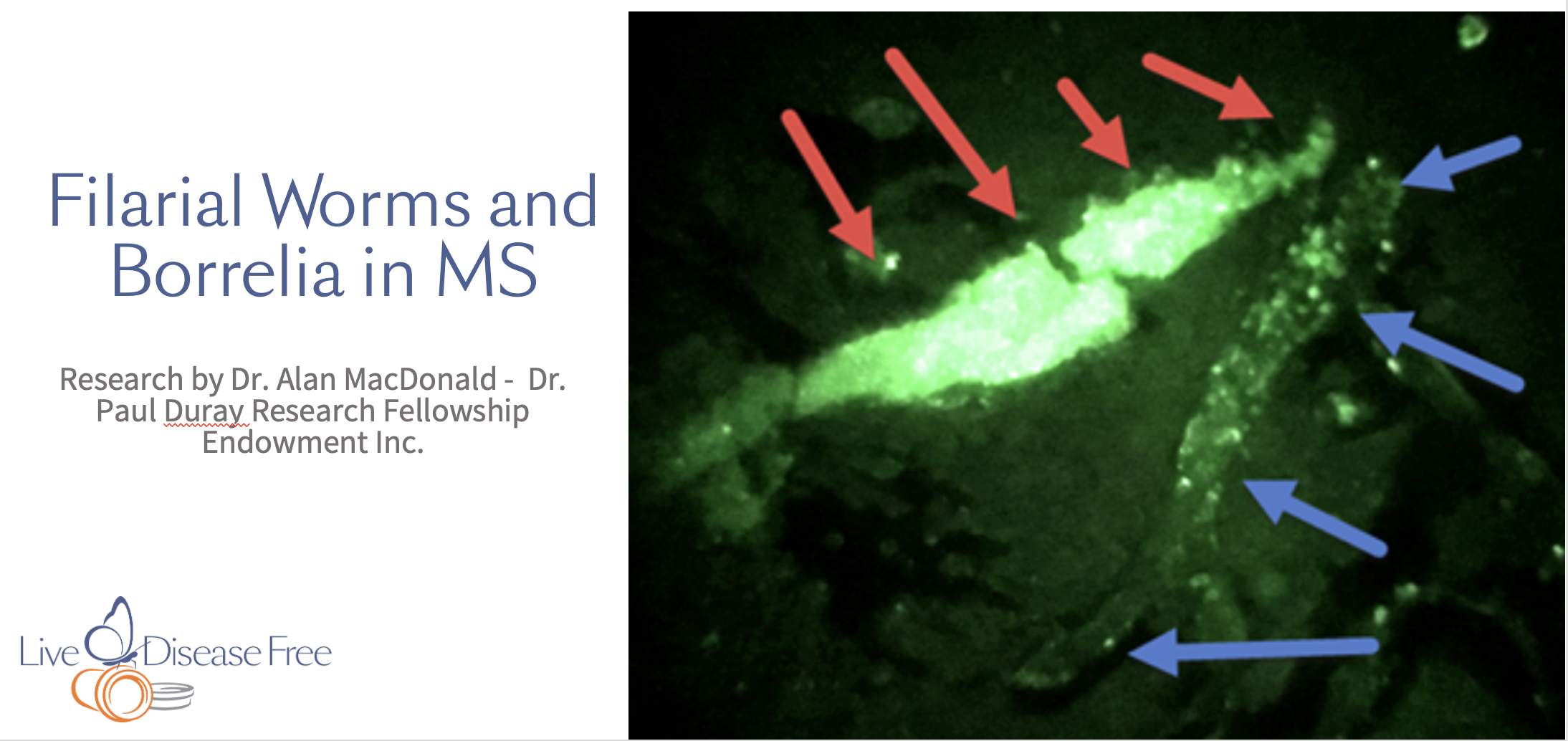
The Veterinary Connection Nobody Talks About
Here’s what makes this discovery even more infuriating: veterinarians have known about this for over 100 years.
Since 1880, veterinary medicine has documented that when filarial worms get into the central nervous system of farm animals—horses, cattle, sheep, dogs—they cause symptoms identical to multiple sclerosis:
- Extreme fatigue
- Weakness and loss of coordination
- Balance problems
- Spasticity and muscle stiffness
- Paralysis
- Loss of myelin
- Blindness
In 1952, two researchers—Dr. Innes from the Royal Society in London and Dr. Shoho from Tokyo—published a paper predicting that the animal model could apply to humans. They said these worms likely cause MS-like disease in people.
They were absolutely right.
But for over 60 years, nobody in human medicine studied this until Dr. McDonald.
The Tapeworm Discovery
Dr. McDonald didn’t stop with filarial worms. In 2021, he published an even more significant finding.
He examined spinal fluid from another group of 10 MS patients. Again, 100% had parasites. But this time, he found tapeworm larvae—microscopic tapeworm larvae ranging from just 10 to 320 microns. That’s smaller than the width of a human hair.
These larvae are invisible to the naked eye. Even experienced doctors doing complete brain autopsies couldn’t see them. They’re that small.
But under the microscope, Dr. McDonald found:
- Cystic larvae with multiple tapeworm heads developing inside
- Juvenile segmented tapeworms up to 323 microns long
- Hatched tapeworm eggs
- Tapeworm hooklets—and interestingly, each patient had unique hooklets, suggesting possibly different species
- Calcium deposits that are typical markers of tapeworm infection.

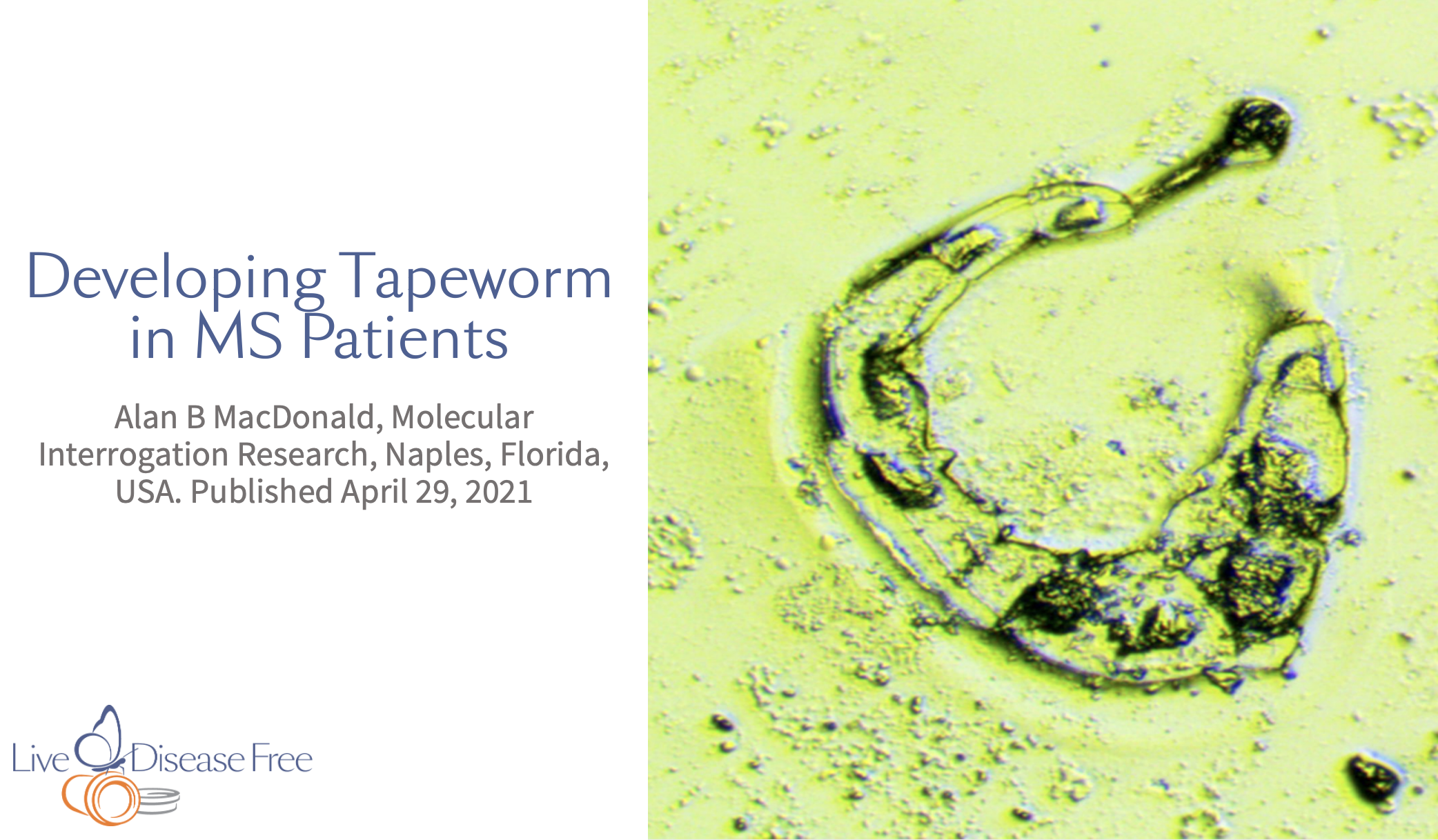
These microscopic larvae form cysts in the brain and spinal cord. And here’s the important connection: in veterinary medicine, this type of tapeworm larvae (called Coenurus) is known to cause brain demyelination in sheep, goats, and primates. The patches of demyelination appear right next to where the parasites are located.
The same pattern we see on MRI scans in MS patients.
Here’s the logical conclusion: If Dr. McDonald is finding tapeworm larvae in the central nervous system of every MS patient studied, then adult tapeworms are almost certainly common in the digestive tract of MS patients as well. The larvae don’t just appear out of nowhere in the brain—they hatch from eggs in the intestine, travel through the bloodstream, and form cysts in the brain and spinal cord.
Which means if you have microscopic tapeworm larvae in your spinal fluid, you have tapeworms in your gut.
And where did these patients get these tapeworm infections? All of them got them in developed countries from pets, agricultural animals, contaminated soil or food and from infected persons containing tapeworm eggs.
This destroys the myth that you only get parasites in underdeveloped countries.
The Garden Analogy: Why Multiple Parasites Matter
When we support students recovering from MS and other chronic diseases, we use a simple analogy: think of your microbiome like a garden.
When a garden becomes out of balance—not enough water, or poor soil—you don’t get just one type of weed. You get dandelions, crabgrass, thistles, bindweed and many others. You get aphids, slugs, and fungus. Multiple pests move in because the whole system is out of balance.
Our body works the same way.
Dr. McDonald found filarial worms and tapeworm larvae because those are what he specifically looked for. But our students who follow the Live Disease Free plan and treat parasites properly are passing much more than just microscopic worms.
They’re passing:
- Large roundworms (Ascaris) up to 2 feet or longer
- Intestinal flukes (flatworms) 3-6 inches long
- Tapeworms in ribbon-like segments
- Plus fungi like Candida, bacteria like Borrelia and Clostridia, and single-celled parasites like Babesia and malaria-type organisms.
It’s very common for someone with MS or another chronic disease to pass hundreds of worms. Not just a few. Hundreds!
Large Roundworms: A Common Worm Infection
Ascaris roundworms are among the most common worm infections worldwide. These large worms live in your small intestine and can grow to a foot long or longer—as thick as a pencil.
Symptoms of roundworm infections include:
- Brain fog and headaches
- Extreme fatigue
- Abdominal pain and bloating
- Constipation or diarrhea
- Muscle cramps and weakness
- Vitamin B12 deficiency
- Coughing and wheezing (when larvae are in the lungs)
A single female ascaris worm can lay 200,000 eggs per day. Up to 100 worms can infect a person at one time.
Our students frequently pass very large roundworms—sometimes over 2 feet long—and they experience remarkable improvements in mental clarity and memory, more strength in their arms and legs, improved sleep and energy and less pain and spasticity.
Read more about large roundworms in MS here.
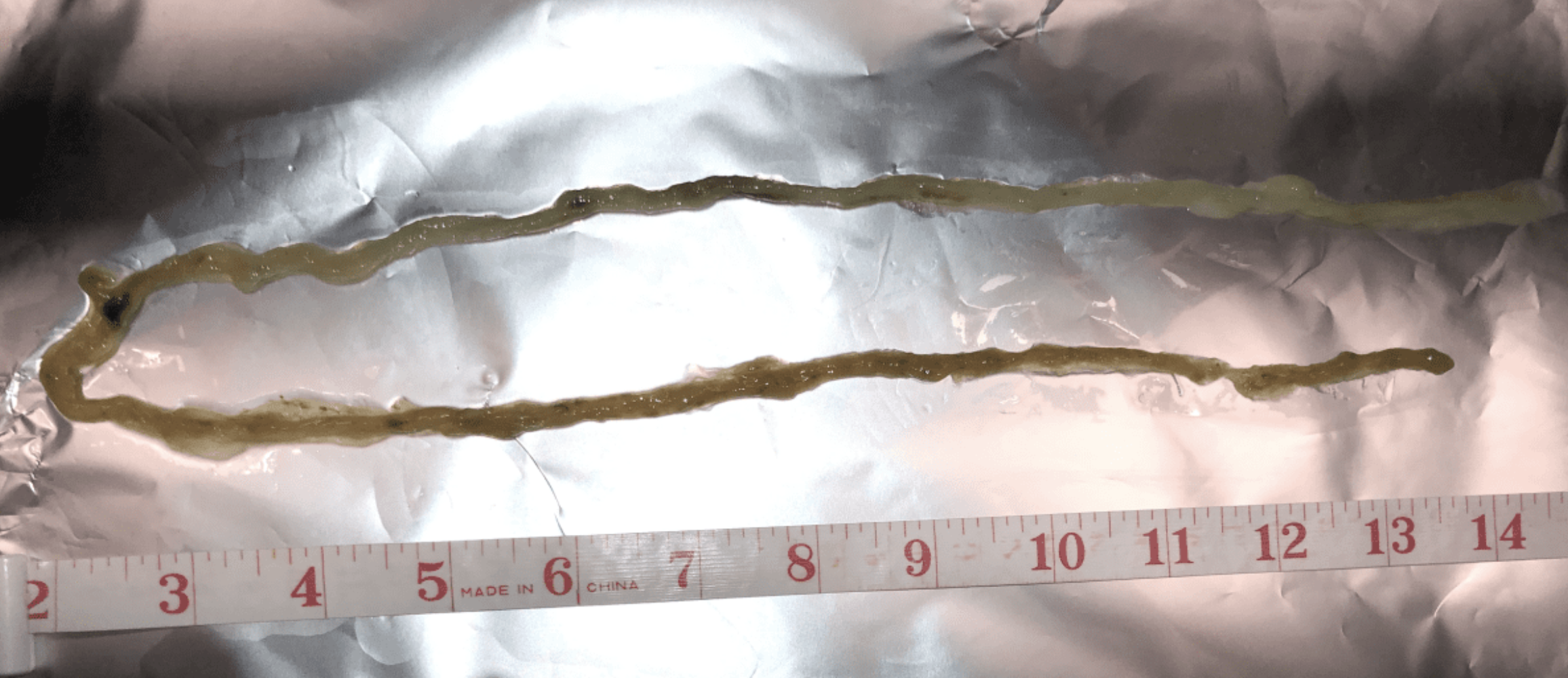
Intestinal Flukes: The Flat, Wide Parasites
Flukes are flat, oval parasitic worms that can infect your blood, intestines, liver, or lungs. The giant intestinal fluke can grow up to 4 inches or more in length and over an inch wide.
Tens of millions of people worldwide are infected with intestinal flukes, mostly through eating contaminated food or water—including raw or undercooked fish, shellfish, aquatic plants, or meat.
Symptoms of fluke infections include:
- Significant inflammation and fatigue
- Abdominal pain, nausea, vomiting
- Poor absorption of nutrients leading to B12 deficiency and anemia
- Mineral imbalances causing muscle cramps and spasticity
- Headaches, dizziness, brain fog
- Memory problems, anxiety, depression
- Nerve symptoms including tingling and numbness.
Flukes weaken your immune system to establish their infection, making you vulnerable to other bacterial and parasitic infections.
Our students are often infected with and pass various types of flukes—they’re wider and shorter than roundworms, often rubbery and see-through white in their tail. When these flukes are passed, inflammation decreases dramatically and quickly.
Learn more about intestinal flukes and MS here.
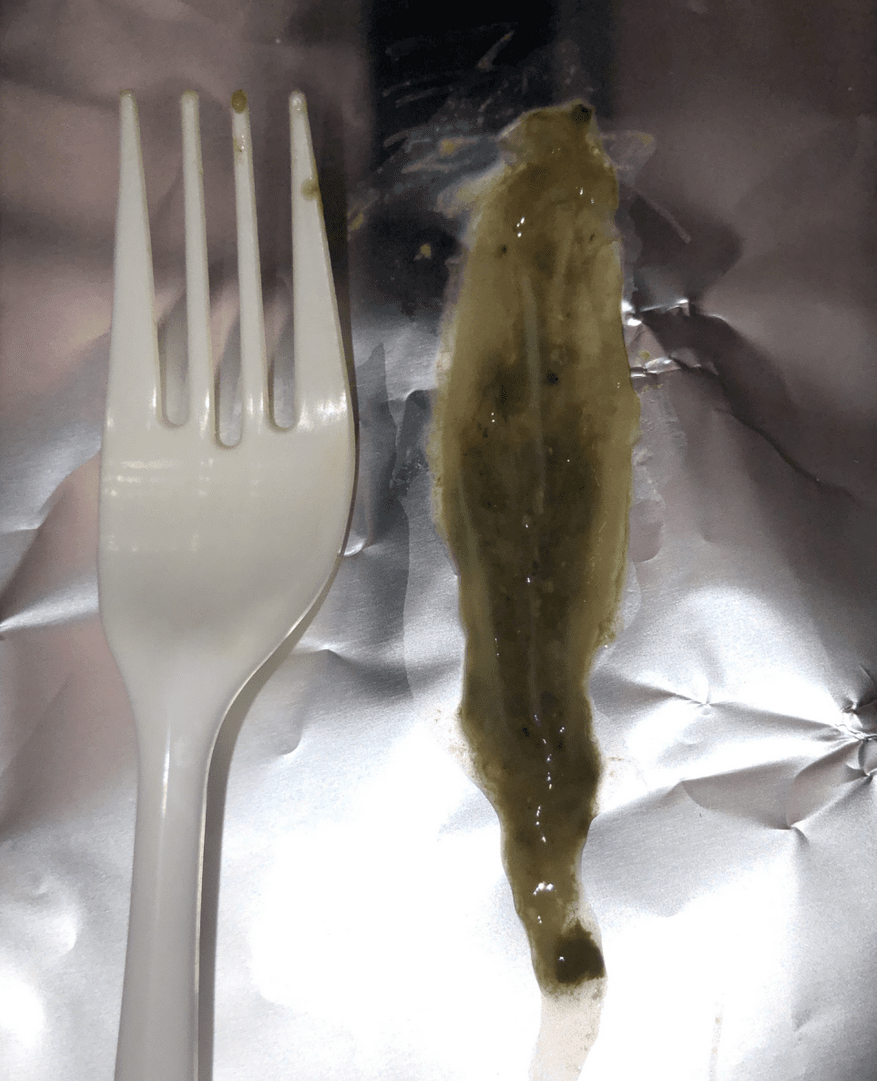
Why This Matters for You
If you have MS or another chronic disease, you’re likely dealing with multiple types of parasites—just like a weedy garden has multiple pests.
The filarial worms and tapeworm larvae that Dr. McDonald found in the central nervous system don’t just appear there out of nowhere. They start in your gut, enter your bloodstream, and travel to your brain and spinal cord.
Which means if you have microscopic worms in your brain and spinal cord, you also have larger worms in your intestines.
And when you treat these parasites effectively—with proper preparation, the right medications in the right combinations, at safe doses along with herbs and oxygen therapies—you can pass these worms and experience life-changing improvements, even recovery.
Our students report:
- Walking again after using wheelchairs or walkers
- Returning to work after years of disability
- Healing their brain function
- Eliminating spasticity, pain, and tremors
- Restoring bladder control and sleep
- Getting their independence back
- Caring for their families and homes.
The Critical Difference: Proper Treatment vs. Self-Medicating
Many people who discover that parasites are causing their symptoms become desperate. They buy parasite medications online and self-medicate.
I understand the desperation. I was there at 28 when I was diagnosed with MS.
But self-medicating is dangerous for three reasons:
First, you’re often treating the wrong parasites. Ivermectin, for example, won’t work on flukes or tapeworms. Fenbendazole isn’t commonly effective for the parasites we see in MS.
Second, even when you’re taking the right medications, the doses people use are often too low to be effective. Taking too little creates drug-resistant parasites that become nearly impossible to treat later.
Third, if you have parasites in your central nervous system and you start killing them without proper preparation and support, you risk a dangerous reaction in the brain. When large numbers of parasites die suddenly, the immune system can overreact, causing potentially life-threatening inflammation and swelling.
This is why proper treatment requires:
- Preparation (diet, detox, sleep, body support) so you’re strong enough to tolerate treatment
- The right combination of parasite medications, herbs, and oxygen therapies
- Proper dosing that’s safe but effective
- Supervision to prevent dangerous reactions
- A treatment sequence that targets larger worms first, then smaller parasites.
Why Doctors Still Aren’t Looking
You might wonder: if Dr. McDonald published these findings in 2016 and 2021, why hasn’t anything changed?
The uncomfortable truth is that there’s no financial incentive to treat parasites.
MS drugs cost $100,000 to $200,000 per year. They’re patented. They’re profitable. Patients take them for life.
Parasite medications are cheap, off-patent, and if they work, patients don’t need them forever.
It’s much more profitable to give expensive immune-suppressing drugs for a lifetime than to treat parasites with safe, inexpensive medications a few times a year.
The system isn’t designed to look for solutions that don’t generate ongoing revenue.
And patients suffer terribly because of it.
What You Can Do
If you’re dealing with MS or another chronic disease, and this information makes sense to you, here’s what I want you to understand:
You don’t have to accept “cause unknown” and “no cure” as your final answer.
The research is there. Dr. McDonald found worms in 100% of MS patients he studied. Veterinary medicine has documented this connection for over a century. Our students are passing these parasites and recovering.
But you can’t do this alone. You need:
- A clear understanding of which parasites cause which symptoms
- A proven preparation phase so your body can handle treatment
- The right medications in the right combinations
- Proper dosing and timing
- Support throughout the process.
CLICK HERE for for life changes successes from our students
Watch videos of our students’ successes
Your Health Is Your Greatest Asset
I’ve been living MS-free for over 35 years by treating the root cause—parasites—while following a holistic approach. I’ve coached thousands of students internationally who are experiencing the same recovery.
People who were told they’d end up in wheelchairs are walking, working, and living full lives again.
Not because they managed their disease. Because they treated the cause.
If you’re frustrated that standard care still doesn’t offer a real solution for MS and other diseases, I want to invite you to watch my free masterclass training.
In this training, I share:
- The complete 4-step Live Disease Free plan
- Detailed research on parasites and MS
- Multiple student success stories—people who went from wheelchairs to walking, from disability to working again
- How to safely and effectively treat parasites
- How you can get support if you need it
Watch Pam’s Free Masterclass Training Here
Your doctor may never look for the parasites causing your symptoms. But that doesn’t mean they’re not there.
And it doesn’t mean you can’t recover.
You just need to take responsibility for your health, become the director of your healthcare, and work with someone who understands how to identify and treat these infections properly.
Because here’s the truth: the biggest parasites cause the biggest symptoms. And when you get them out, everything can change.
For educational purposes only. This information is not intended to replace the care of your healthcare professional.
There are real solutions to recover from parasites today!
To restore health, we must focus on treating the cause of inflammation, which are parasites. First, identify the enemy (parasites), then support the body and treat the parasites while following a holistic approach. When parasitic infections are treated effectively, we can overcome inflammation or disease.
If you’re frustrated with the fact that our standard of care STILL doesn’t offer a real solution for treating MS and other diseases, then click on the link below to watch Pam Bartha’s free masterclass training and discover REAL solutions that have allowed Pam and many others to live free from MS and other diseases.
CLICK Here to watch Pam’s masterclass training
About Pam Bartha
Clinically diagnosed with multiple sclerosis at the age of 28, Pam Bartha chose an alternative approach to recovery. Now decades later and still symptom free, she coaches others on how to treat the root cause of chronic disease, using a holistic approach. She can teach you how, too.
Pam is the author of Become a Wellness Champion and founder of Live Disease Free. She is a wellness expert, coach and speaker.
The Live Disease Free Academy has helped thousands of Wellness Champions in over 15 countries take charge of their health and experience profound improvements in their life.
References:
https://f1000research.com/posters/5-79
https://www.youtube.com/watch?v=EHVXJpDBcmU
https://f1000research.com/posters/9-1062

Clinically diagnosed with multiple sclerosis at the age of 28, Pam chose an alternative approach to recovery. Now decades later and still symptom free, she coaches others on how to treat the root cause of chronic disease, using a holistic approach. She can teach you how, too.
Pam is the author of Become a Wellness Champion and founder of Live Disease Free. She is a wellness expert, coach and speaker.
The Live Disease Free Academy has helped hundreds of Wellness Champions in over 15 countries take charge of their health and experience profound improvements in their life.

